You can make organic mosquito dunks with just flour, sugar, yeast, and water. Mix ingredients to create a breeding ground, let ferment, then form into discs and dry in the sun. These homemade dunks target mosquito larvae in standing water and last about 30 days without harming beneficial insects. Place them in shaded areas near standing water for maximum effectiveness. The simple ingredients in your kitchen can become your best defense against mosquito invasions.
Make Organic Mosquito Dunks With Simple Materials
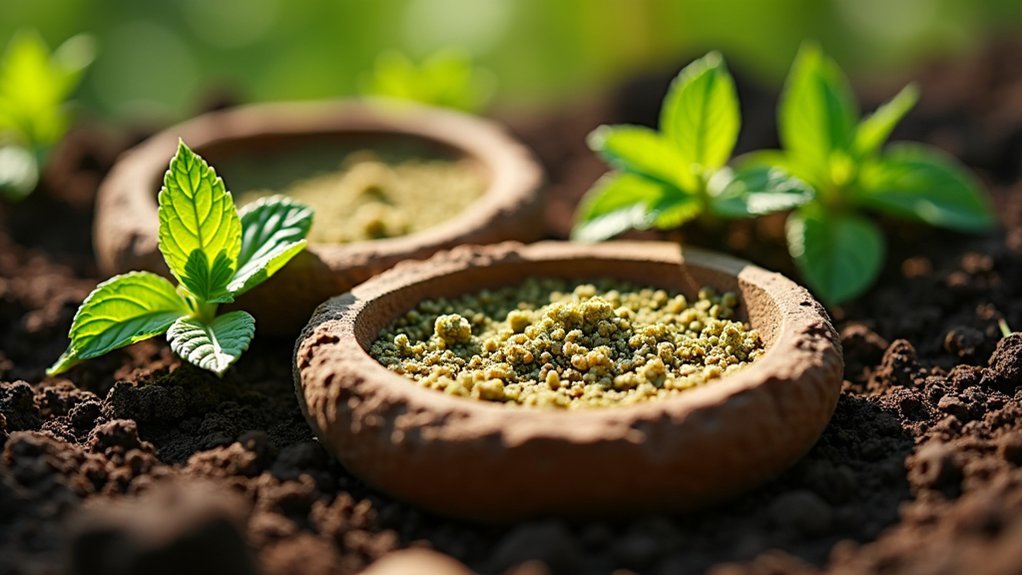
While commercial mosquito control products often contain chemicals, you can easily make organic mosquito dunks at home with ingredients from your kitchen. The process requires just three basic components: flour, sugar, and yeast, which create an organic matter mixture that attracts mosquitoes.
Combine 1 cup of flour, 1 cup of sugar, and 1 tablespoon of yeast with enough water to form a thick paste. This mixture serves as the perfect breeding ground for mosquitoes to lay eggs.
Creating a simple, effective mosquito trap requires only kitchen staples: flour, sugar, yeast, and water mixed to perfect egg-laying consistency.
Unlike commercial dunks containing Bacillus thuringiensis, these homemade versions work by trapping mosquito larvae in the fermenting mixture.
After fermenting for a few days, form the mixture into balls or discs and dry them in the sun. These natural mosquito dunks will effectively control larvae for about 30 days without harming beneficial insects.
Understanding Mosquito Life Cycles and Control Points
To effectively control mosquito populations with your homemade dunks, you’ll need to understand their life cycle and identify critical intervention points. Mosquitoes develop through four stages—egg, larva, pupa, and adult—with the entire process taking as little as 7-14 days in warm weather.
- Target the larval stage – This is when mosquitoes are most vulnerable and confined to water, making it the perfect time to deploy your homemade dunks.
- Focus on standing water – Female mosquitoes seek stagnant water to lay their eggs, so treating bird baths, rain barrels, and puddles disrupts reproduction.
- Time your treatments – Apply dunks every 30 days, especially before dawn and dusk when adult mosquitoes become active, to break the breeding cycle.
The Problem With Commercial Sprays and Chemical Solutions
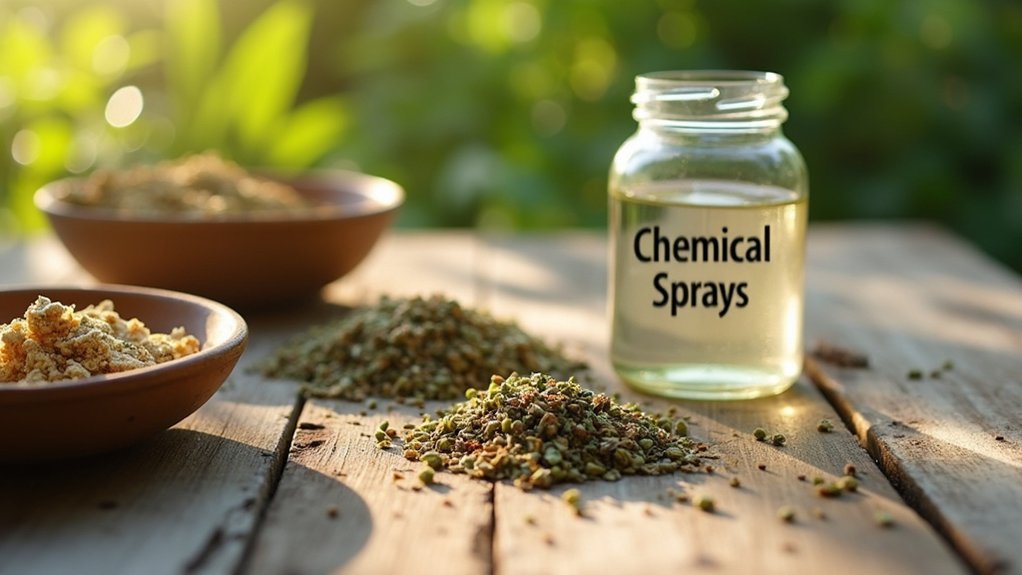
Commercial mosquito sprays offer temporary relief at a high cost—they’re expensive for their short-lived effectiveness and require frequent reapplications every 1-3 days.
You’ll find these chemical solutions harm beneficial insects like bees and butterflies while potentially introducing health risks to your family and pets.
Your yard’s ecosystem suffers as these sprays miss mosquito larvae completely, addressing only a fraction of the problem while creating new environmental concerns.
Environmental Impact Issues
Although many people rely on store-bought pesticides for mosquito control, these chemical solutions come with significant environmental consequences. When you spray these chemicals, they don’t discriminate between harmful and helpful species, creating ripple effects throughout your local ecosystem.
- Chemical sprays harm beneficial insects like bees, butterflies, and lightning bugs, disrupting pollination and natural pest control systems.
- Environmental concerns extend to water sources, where pesticide runoff can contaminate streams and ponds, damaging aquatic life.
- Frequent application of pesticides contributes to insecticide-resistant mosquito populations, making future control more difficult and expensive.
These impacts, combined with the short-lasting effectiveness of commercial sprays (typically just 1-3 days), make chemical solutions both environmentally harmful and inefficient for long-term mosquito management.
Health Risk Concerns
While battling mosquitoes seems straightforward with store-bought solutions, many commercial mosquito sprays harbor concerning health risks for you and your family.
These chemical mosquito solutions often contain toxins that can accumulate in your body over time, especially with repeated exposure during mosquito season.
What’s more troubling is that despite these health risks, conventional sprays only target adult mosquitoes, leaving larvae untouched and requiring frequent reapplications every 1-3 days.
This continuous exposure increases potential dangers to humans and pets alike.
Effective mosquito control shouldn’t compromise your family’s wellbeing.
As mosquitoes develop resistance to these chemicals, manufacturers often respond by creating even stronger formulations with potentially more harmful ingredients, creating a dangerous cycle of increasing toxicity in your living environment.
Expense and Ineffectiveness
Beyond health concerns, the financial burden of commercial mosquito treatments adds up quickly.
You’re spending money on products that deliver minimal results while potentially harming your garden’s ecosystem. Commercial sprays primarily target adult mosquitoes in flight, missing those resting or breeding in standing water.
Here’s why these solutions fail to provide value for your investment:
- Limited duration – Effectiveness typically lasts only 1-3 days, requiring frequent repurchasing and reapplication.
- Incomplete control – Most products don’t address the larval stage in standing water, where mosquito populations actually develop.
- Resistance development – Continuous use of chemical solutions creates resistant mosquito populations, requiring stronger (and more expensive) products over time.
This cycle of expense and ineffectiveness makes finding sustainable alternatives not just environmentally responsible, but economically sensible too.
Gathering Natural Ingredients for DIY Mosquito Dunks
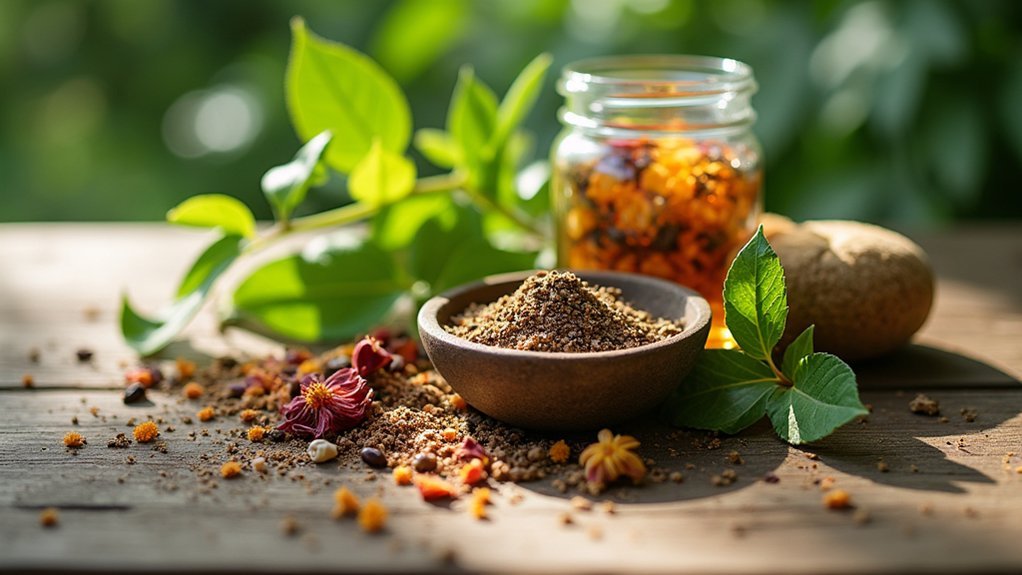
Before starting your organic mosquito control project, you’ll need to collect the right natural materials that attract mosquitoes for egg-laying.
Look for dried hay, straw, or grass clippings in your yard or garden—these forms of organic matter create an irresistible environment for female mosquitoes.
You’ll also need a 5-gallon bucket to combine these ingredients with water, creating the perfect breeding ground that will ultimately become a trap.
The key component in your DIY dunk is Bacillus thuringiensis israelensis (Bti), a natural larvicide that specifically targets mosquito larvae without harming beneficial insects or wildlife.
For maximum effectiveness, guarantee your organic matter is partially decomposed rather than fresh.
This decay process releases compounds that mosquitoes find particularly attractive when seeking places to deposit their eggs.
Step-by-Step Guide to Creating Your Own Organic Dunks
After gathering all your natural materials, you’re ready to mix and form your homemade mosquito dunks. These organic dunks provide an effective, natural way to prevent mosquitoes from developing in standing water where they typically lay eggs.
- Combine 1 cup cornmeal, 1 cup sugar, and 1 tablespoon of yeast in a bowl, creating a nutrient-rich base that will nourish beneficial bacteria that kill mosquito larvae.
- Add enough water to create a thick slurry, then pour into molds or shape by hand into disk forms that can float on water surfaces.
- Allow your dunks to dry thoroughly for at least 24 hours in a well-ventilated area before placing them in standing water where mosquitoes breed.
Replace your organic dunks monthly for continuous protection throughout mosquito season.
Setting Up and Positioning Your Mosquito Trap Buckets
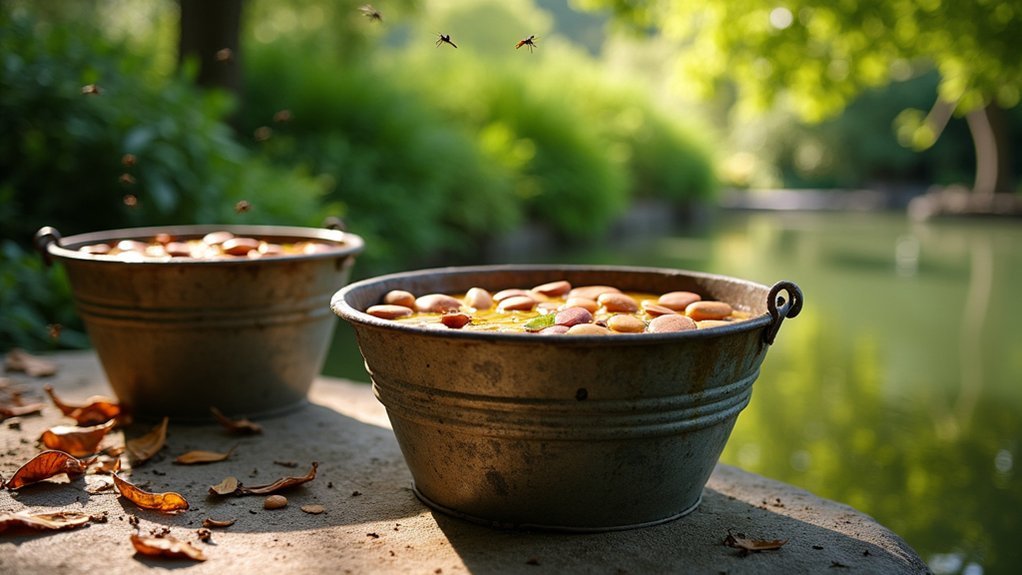
Strategic placement of your mosquito trap buckets dramatically increases their effectiveness in controlling the local mosquito population.
Position your five-gallon buckets in shady, moist areas where female mosquitoes naturally gravitate for egg-laying. These locations create the perfect environment to attract adult mosquitoes seeking breeding sites.
Fill each bucket halfway with water and add grass clippings to create an enticing organic mixture that mimics natural breeding conditions.
While you’ll want traps near seating areas to intercept mosquitoes, maintain sufficient distance to prevent unwanted swarming around your gathering spaces.
Remember to place buckets away from high-traffic zones while ensuring they remain accessible for regular maintenance.
The consistent moisture in properly positioned buckets will continuously attract mosquitoes, making your organic dunks more effective at controlling their population.
Maintaining Your DIY Dunk System Throughout the Season
Once you’ve established your mosquito control system, regular maintenance becomes crucial for season-long effectiveness. The dunk kills the larvae without harming beneficial insects, but only when properly maintained.
Position your buckets in shady, moist areas to attract female mosquitoes while reducing evaporation.
- Check and refill water levels every two weeks to maintain ideal conditions and prevent stagnation.
- Replace the Mosquito Dunk every 30 days to guarantee it continues effectively controlling the mosquito population.
- Monitor for foul odors regularly—if you detect any bad smell, replace the contents immediately to keep the system attractive to mosquitoes.
After heavy rainfall, remember to pour off excess water to prevent overflow.
With consistent maintenance, your DIY dunk system will provide effective mosquito control throughout the entire season.
Combining Dunks With Other Natural Mosquito Deterrents
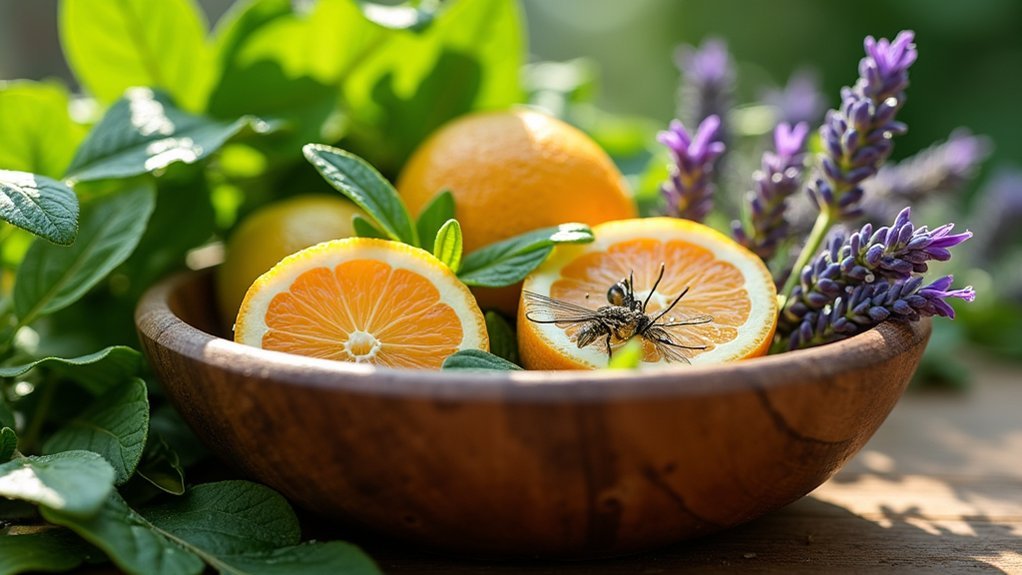
While Mosquito Dunks® work effectively on their own, combining them with complementary natural elements creates a more powerful defense system against mosquitoes.
Enhance your dunk’s effectiveness by adding organic materials like grass clippings or decaying leaves, which attract female mosquitoes seeking egg-laying sites.
Place your dunk systems in partially shaded areas to maintain cooler water temperatures, maximizing the Bti’s larvicidal action.
For thorough protection, surround your dunk buckets with natural deterrents like citronella or eucalyptus leaves to repel adult mosquitoes from the vicinity.
The key to success lies in creating the perfect balance of attraction and elimination.
Regularly refresh your organic materials to maintain a continuous food source for larvae, ensuring they consume the Bti before they can mature into biting adults.
Frequently Asked Questions
How Do You Make Organic Mosquito Killer?
To make organic mosquito killer, mix 1 tablespoon sugar with active dry yeast in warm water. Add decaying organic matter, place in a shallow container covered with mesh, and incorporate Mosquito Dunks® to kill larvae.
What Is the Best Homemade Mosquito Trap?
The best homemade mosquito trap uses a plastic bottle with the top inverted into the bottom half. Fill it with sugar, yeast, and water to produce CO2 that attracts mosquitoes. Place in shady, high-activity areas.
What Are the Ingredients in Mosquito Dunks?
Mosquito Dunks contain 5% Bacillus thuringiensis israelensis (Bti), a natural bacterium that kills mosquito larvae. The rest consists of inert ingredients that help release the Bti gradually over 30 days in standing water.
Can I Make My Own Mosquito Eradicator?
Yes, you can make your own mosquito eradicator with sugar, yeast, and warm water in a plastic bottle. Mix them together, cut the bottle in half, invert the top, and tape it closed to trap mosquitoes.
In Summary
You’ve now mastered making organic mosquito dunks that don’t harm beneficial insects or contaminate your garden. They’re cost-effective, environmentally friendly, and you can customize them to your specific needs. By understanding mosquito breeding cycles and combining these dunks with other natural solutions, you’ll enjoy more comfortable outdoor time this summer. Remember to replace your dunks every few weeks for continuous protection.

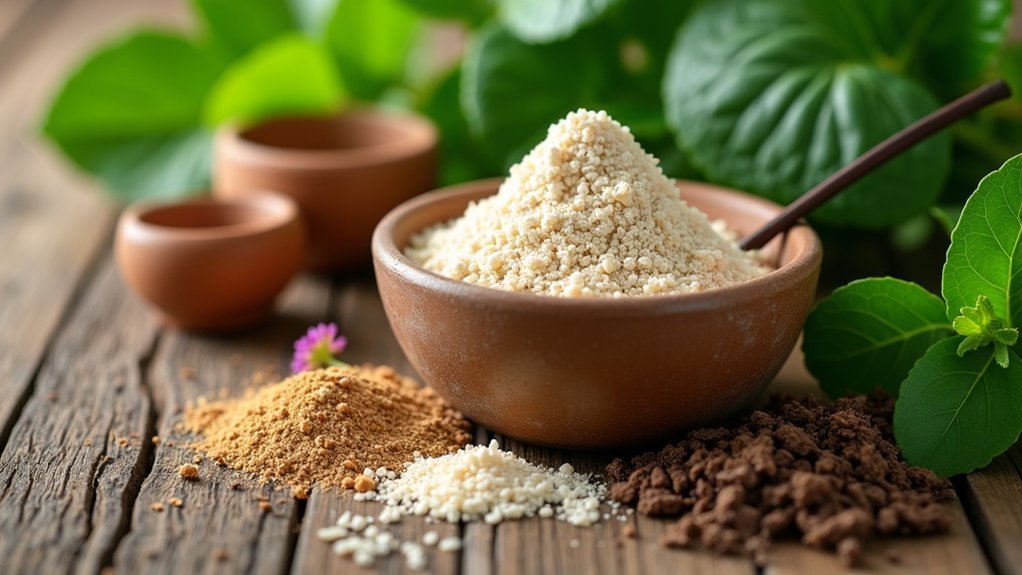



Leave a Reply